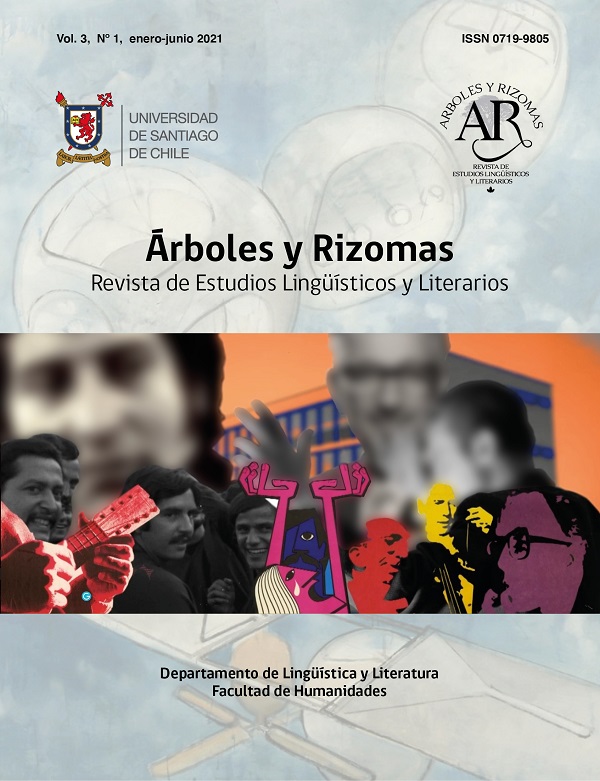Contradictions of the plot in Roberto Bolaño’s short stories
DOI:
https://doi.org/10.35588/ayr.v3i1.4887Keywords:
plot, narrative time, aesthetics, Bolaño, short storyAbstract
This article examines the narrative strategies used by Bolaño in those stories marked by a undermining of the plot. The virtuality of the narrative action, the anti-closures, the lyricism and the conjectures are considered as substitutes for the narrative nexus that allow the unity and completeness of the story. Despite the openness, the episodic nature of the actions, the apparent lack of selections from these and the spatiality inherent in lyricism and guesswork, the stories have the characteristic unity of the plot. It is precisely in the characteristics of the plot and the procedures used that Bolaño's aesthetic proposal is evident and the starting point of the interpretation of its meaning as a socially symbolic object. In this sense, the tensions observed in the configuration of the plot in relation to the intelligibility of human action are interpreted, evaluating the pessimism of Bolaño's narrative within the framework of the literary cycle to which it belongs and the descriptions of its production made by critics like Grinor Rojo.
Downloads
References
Aguilar, P. (2015). Fantasma, memoria y poesía desde “Últimos atardeceres en la tierra” de Roberto Bolaño. En Aguilar, P. y Basite, T. (Eds.). Bolaño en sus cuentos, (pp. 125-135). Leiden: Alemenara.
Andrews, C. (2003) ‘Algo va a pasar’: los cuentos de Roberto Bolaño. En Moreno F. (Coord.) Roberto Bolaño: una literatura infinita, (pp. 33-40). Poitiers: Université de Poitiers.
___________ (2008). La experiencia episódica y la narrativa de Roberto Bolaño. En Paz Soldán, E. y Faverón. G. (Comps.). Bolaño Salvaje, (pp. 53-72). Barcelona: Candaya.
___________ (2015). Epifanías e inminencia en los cuentos de Roberto Bolaño. En Aguilar, P. y Basile T. (Eds.). Bolaño en sus cuentos, (pp. 27-42). Leiden, Países Bajos: Almenara.
Aristóteles (2013). Poética. México D.F.: Porrúa.
Ayala, M. (2008). Notas sobre la poesía de Roberto Bolaño. En Paz Soldán, E. y Faverón. G. (Comps.). Bolaño Salvaje, (pp. 09-10). Barcelona: Candaya.
Bajtín, M. (1989). Teoría y estética de la novela. Madrid: Taurus.
Bal, M. (1990). Teoría de la narrativa. Madrid: Cátedra.
Benjamin, W. (2007). Conceptos de filosofía de la historia. Buenos Aires: Terramar.
Bremond, C. (1972). La lógica de los posibles narrativos, en Barthes et al. Análisis estructural del relato, (pp. 87-109). Buenos Aires: Tiempo contemporáneo.
___________ (1974). El mensaje narrativo. En Barthes, R. et al. La semiología, (pp. 75-104). Buenos Aires: Tiempo contemporáneo.
Bolaño, R. (2001). Putas asesinas. Barcelona: Anagrama.
_________ (2004). Entre paréntesis. Barcelona: Anagrama.
_________ (2009). El gaucho insufrible. Barcelona: Anagrama.
_________ (2018). Cuentos completos. Santiago: Alfaguara.
Borges, J.L. (1999). Prólogo. En Bioy Casares, A. La invención de Morel. Buenos Aires: Emecé.
Corral, W. (2011). Bolaño traducido. Nueva literatura mundial. Madrid: Escalera.
Eco, U. (1992). Obra abierta. Barcelona: Planeta-De Agostini.
Hegel, G.W. F. (2011). Lecciones sobre la estética. Madrid: Akal.
Jameson, F. (1989). Documentos de cultura, documentos de barbarie. Madrid: Visor.
_________ (2013). Las valencias de la historia. En Valencias de la dialéctica. Buenos Aires: Eterna Cadencia.
Kermode, F. (2000), El sentido de un final. Barcelona: Gedisa.
Lotman, Y. (2011). Estructura del texto artístico. Madrid: Akal.
Lukács, G. (1966). Narrar o describir. A propósito de la discusión sobre naturalismo y formalismo. En Problemas del realismo, (pp. 171-216). México D.F.: Fondo de cultura económica.
Moretti, F. (2015). Lectura distante. Buenos Aires: Fondo de cultura económica.
Piglia, R. (2017). Formas breves. Buenos Aires: Debolsillo.
Rancière, J. (2009). La palabra muda. Ensayo sobre las contradicciones de la literatura. Buenos Aires: Eterna cadencia.
__________ (2011). Política de la literatura. Buenos Aires: Libros del Zorzal.
Ricoeur, P. (2017). Tiempo y narración II. Configuración del tiempo en el relato de ficción. México: Siglo XXI.
_________ (1997). Narratividad, fenomenología y hermenéutica. En Cuaderno Gris. Época III, 2 (1997): 479-495. Monográfico: Horizontes del relato: lecturas y conversaciones con Paul Ricoeur / Gabriel Aranzueque (coord.)
Rojo, G. (2016). Las novelas de la dictadura y posdictadura chilena. ¿Qué y cómo leer? Santiago: Lom.
Ríos, F. (2015). Fuera de aquí: la literatura más allá de lo literario en la cuentística de Bolaño. En Aguilar, P. y Basile T. (Eds.). Bolaño en sus cuentos, (pp. 13-26). Leiden: Almenara
Solotorevsky, M. (2009). El “espesor escritural” en dos cuentos de Roberto Bolaño: “Últimos atardeceres en la tierra” y “Dentista”. En Revista laboratorio. Literatura y experimentación. https://revistalaboratorio.udp.cl/index.php/laboratorio/article/view/100/94
Tinianov, J. (1970). Sobre la evolución literaria. En Todorov, T. (comp.) Teoría de la literatura de los formalistas rusos, (pp. 89-101). Buenos Aires: Signos.
Todorov, T. (2012). Los géneros del discurso. Buenos Aires: Waldhuter.
Tomashevski, B. (1970). Temática. En Todorov, T. (comp.) Teoría de la literatura de los formalistas rusos, (pp. 199-232). Buenos Aires: Signos.






